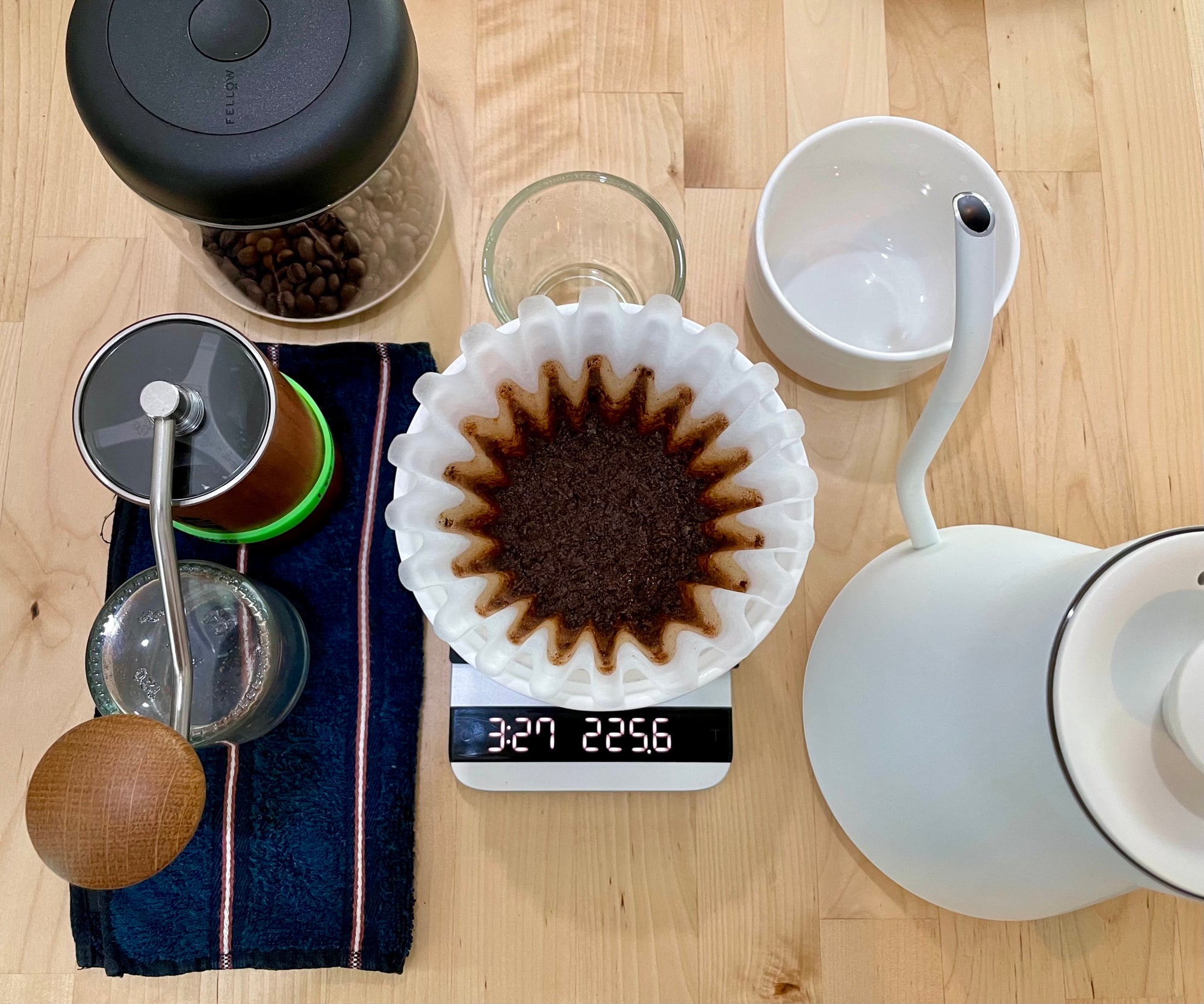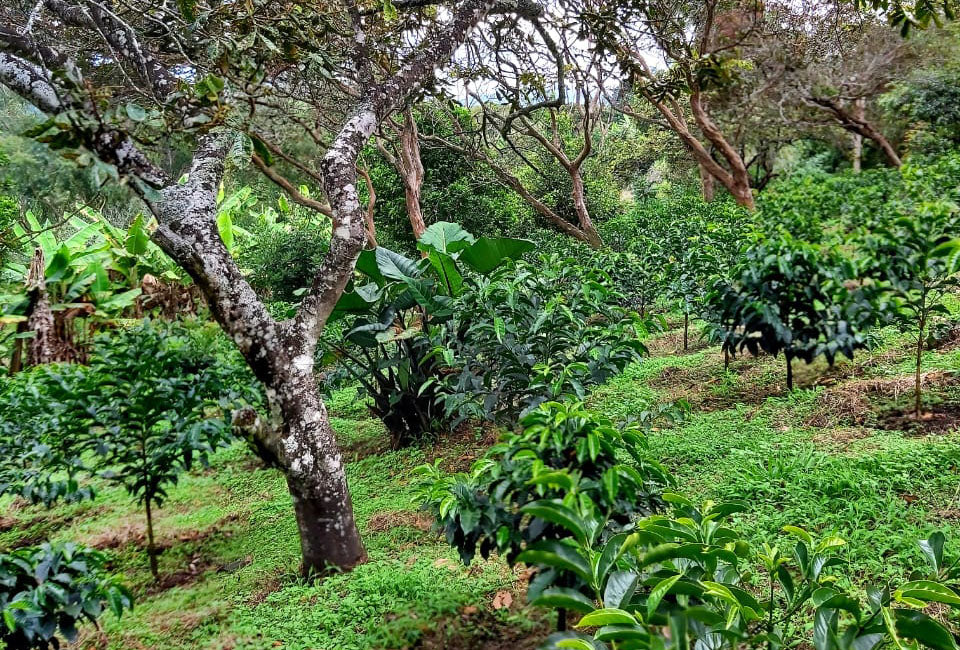Hong Kong-based KC approached us early in 2021 researching how to best adapt and replicate our World Brewers Cup formula One (1:1:1) to suit the Kalita Wave or the April/Serax Brewer.
KC had researched and performed the recommended One (1:1:1) brewing method on the the Coffea Circulor web site and the Jan Junglas post [1]. While using and reflecting upon the method and its delivery, KC says: "The method is very useful which highlights the aroma of the stunning coffee, especially the fruity acidity".
KC continues: However, when I use Kalita Wave or April Brewer instead of V60 (keeping other variables constant, Comandante starting from 28 clicks), the flow rates are indeed slower, up to 3:30 to 4:00 or even 4:30 min. The question is then how we could work together to achieve a slightly longer brew time for this kind of flat-bottom brewers. It would either be that or keep grinding coarser to achieve the 03:00 min recommended brew time for One (1:1:1). KC was wondering wondering sometimes since Commandante at 30-32 clicks may actually compromise the extraction and lose some flavors in the cup.
We recommended to try with one brew with the same settings. However, it would b advisable to grind slightly finer, towards 25 on the Commandante because April and Kalita tends to flow ‘faster’. This was just the start for KC's conducted experiments.
Calibration begins
KC received the coffees on an early January morning. To start a calibration process, a sample of a unreleased Ethiopia Kiburi natural was provided. While letting the beans rest for 5-7days, he revisit the recommended brewing recipe.
Regarding your brewing recommendations on WBrC 1:1:1 recipe, I have tried a few settings on the La Esperanza Sudan Rume Natural (by Colonna) and some La Esmeralda Geisha (by Coffee Collective) with the April brewer using wave 155/185 filter papers.
Using 28 clicks on Comandante, 15g in 225g out, volvic mineral water, 75g water/pour, 20s circular pour each, 2nd and 3rd pour at 1:00 and 02:00. I obtained quite a consistent brewing time range between 3:30 - 4:00.
If I go finer towards 25 clicks, keeping other parameters unchanged, a consistent brewing time range between 3:45 - 4:30 will be obtained. However, a little bit of astringency was tasted in the final cup if grinding this fine.
In view of the above calibration process, I plan to keep grinding coarser, maybe up to 30-34 clicks range to see if the grind settings can give me a roughly consistent 3 min total brew time and see how the actual cup tastes for this kind of coarse grind settings.
Or, referencing the Jan [1] post, which the WBrC recipe's "scalability can also directly be transferred to the timing as well as long as you retain temporal consistency." I am thinking of scaling down the "time" factor by shortening the pouring time to 15s for each circular pour, 2nd and 3rd pour at 00:45 and 01:30, target brew time 02:15 (keeping 15g in, 225g out).
Part II
We investigate locally as well. About One (1:1:1) and how it relates to Kalita/April, our recommendation is to grind at least +2 from 28 on Commandante. If you find you current brew - regardless coffee / supplier - to go much beyond 03:00, then you would should slow down the flow. Choice of water of course has an impact as well. What we saw at in the first trials was usage of less coffee, less water (15/225) and still the brew ended up with a total brewing time over 03:00, and with no significant change if you go finer towards 25 on Commandante.
If using 15g/225g, enables one to linearly "scale down” the pouring to 15 seconds, preferably with at least 5 circular pulses where the last also pours towards the “walls” to ensure no grinds “stick” to the filter. All grinds have to be kept submerged. Also, when using 15 seconds in the pour, each circular motion will be about 3 seconds, but remember that pouring towards the rim, the pouring is performed slower than it is while it is close to the centre.

Part III
KC adopted the advice and brewed with Ethiopia Odaco and Ninety Plus Kambera.
“I found that the TBT is relatively stable thanks to your different approach to roasting coffee.” - KC
I kept all the parameters unchanged. April brewer, Kalita Wave 155. 15g in 225g out. Volvic bottle water, 94'C. Gentle circular pour for 5 concentric circles for 18-20s. Pour at 00:00, 01:00 and 02:00 minutes. Comandante was set on 30-34 clicks.
- Ensuring a flat bed after each pouring. Especially after the first pour, I tried to pour very gently to avoid too much agitation of the coffee bed. Also I ensured the last pour was towards the wall to prevent craters. However, even there is a flat bed right after each pouring, the bed will slowly dwell down and form a small well, with the centre of the coffee bed slightly lower than those on the rim. On the other hand, ensuring flat bed after second and final pour were much more easy and consistent.
- If I grind too coarse, like 32-34 clicks, the TBT will be close to 3:10-3:20 but the taste will be a bit hollow and grassy. Then I ground a bit finer back to 28-30 clicks, it gave stable TBT, but still always around 3:30 and very consistent 3.5 min.
- By keeping grind size close to 28 clicks, I have slight modify the recipe to (1:2:2) as an experiment, using 45g water (circular pouring of 10s) to wet the coffee grounds first, then 90g (circular 20s) at 00:40 and 90g (circular 20s) at 01:40, I found the TBT will be close to 3min each time. (I hope you don't mind that I modified your recipe, I just want to see if 3min is still a golden TBT for this kind of flat-bottom brewer like April brewer. Or change the target brew time to 3:30.)
- I found that the TDS of the Volvic water in Hong Kong is around 130mg/L so I have bought another mineral water Sant'Anna water (from Italy) which only contains a TDS of 22mg/l. I will let you know if brewing with a lower TDS water with a flat bottom brewed makes a difference.
- The Ninety Plus Gesha is stunning and the rum cake / Black Forest cake flavours are distinguishing! We love it a lot!!

Part IV
At this point, KC provided an update after changing the water to Sant'Anna.
"I found that by using the Sant'Anna water (with a TDS of 22mg/ml), the brews provide a more prominent acidity than by using Volvic water. The total brew times were quite similar for both Sant'Anna and Volvic (TDS 22 vs 130 mg/ml) so I think the water TDS does not make a huge difference in the brew time but does matter in the extraction profile. More fruity and acidity notes were experienced by using water with lower TDS."

Conclusion
"Regarding the total brew time issue, I have compared the TBT on a V60 and on an April brewer (flat-bottom brewer). I keep the beans in the Fellow Atmos to retain the freshness and for consistency purposes, I can now achieve a consistent brew time of around 03:00-03:15 on a V60. On the other hand, the brew times on April brewer were around 03:15-03:30. Therefore, I am still wondering if different designs of coffee brewer kits (cone shaped V flat-bottom shaped) should have slightly different brew time. That's still a struggle for me."
KC continues: "Except the Ethiopia Natural beans, thanks to their higher density maybe, the brew times were longer up to 04:00-04:30. The main reason was the stalling issue after the final pour of the water. I have kept the pouring kettle heated and held at 94'C to ensure sufficient temperature and "energy" for the extraction/drawdown in the last phase, but the stalling still occurs. Having said that, earthy or those nutty notes were not tasted in the final cups. And that's why it frustrated me about finding the most "suitable" brew time for the "sweet spot" because the ranges seem to be quite large and lenient as longer brew time seems not to ruin the final cup much in the April brewer."
“Communicating on a global scale is crucial for prevailing in coffee. One can gain much by building together.” - Ivica
Our vision is to follow up experiences based on science, knowledge-based sharing and strive for optimization. In KC's case, it shows how working together we can adapt given and researched frameworks such as the One (1:1:1) and redefine it for a new purpose.
[1] https://coffeacirculor.com/blogs/news/brewer-profile-jan-junglas
Photo courtesy of KC.
Follow KC on Instagram: @kc._.jai



